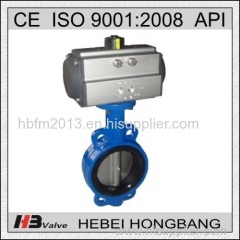.jpg)
Type LT Wafer Butterfly Valve
| Payment Terms: | L/C, T/T |
|---|---|
| Supply Ability: | According to requirment |
| Place of Origin: | Shanghai |
Company Profile
| Location: | Shanghai, China (Mainland) |
|---|---|
| Business Type: | Manufacturer, Service |
Product Detail
| Model No.: | BV-005 |
|---|---|
| Means of Transport: | Depending on quantity |
| Brand Name: | DaZhong |
| Function: | For industrial use |
| Patent Rights: | Belong to our company |
| Certificate: | API 6D, ISO 9001:2000 |
| Export Area: | All over the world |
| Production Capacity: | According to requirment |
| Delivery Date: | 20-50 days |
Product Description
This kind of valve has a circular disk as its closing element. The standard design has the valve stem running through the disk, giving a symmetrical appearance. Later designs off-set the stem, so that the disk "cams" into the valve seat. Advantages include less wear and tear on the disk and seats, and tighter shut-off capacities. Many design types are available including inexpensive? Teflon or resilient seats for use in water(treatment) plants, etc. More expensive metal seats can be used where high temperatures or aggressive chemicals are encountered. So-called "High Temperature" butterfly valves offer zero leakage designs and have been applied in both the chemicals and hydrocarbon processing sectors.
The above attached product's specification is as following:
Specifications:
1) Size: DN50 (2") ~ DN600 (24")
2) Pressure: PN10, PN16, 125LB
3) Material:
a) Body: ductile iron, cast iron, stainless steel, carbon steel
b) Disc: plated ductile iron, aluminum bronze, stainless steel
c) Stem: stainless steel
d) Seat: NBR, EPDM, FKM, and CR
4) Standards:
a) Valve design to: API609
b) Valve test to: API598, GB13927
c) Face to face: API609
d) Flange drilled is according to: GB/T17241, ANSI B16.42, ANSIB 16.1, and EN1092-2
The above attached product's specification is as following:
Specifications:
1) Size: DN50 (2") ~ DN600 (24")
2) Pressure: PN10, PN16, 125LB
3) Material:
a) Body: ductile iron, cast iron, stainless steel, carbon steel
b) Disc: plated ductile iron, aluminum bronze, stainless steel
c) Stem: stainless steel
d) Seat: NBR, EPDM, FKM, and CR
4) Standards:
a) Valve design to: API609
b) Valve test to: API598, GB13927
c) Face to face: API609
d) Flange drilled is according to: GB/T17241, ANSI B16.42, ANSIB 16.1, and EN1092-2
Features:
1) Small in size and light in weight; easy in installation and maintenance; can be mounted wherever needed
2) Small torque of operate, energy saving
3) Flow curve tending to straight line. Excellent regulation performance
4) Long service life. Standing the test of tens of thousands opening/closing operation
5) Perfect sealing without leakage under the pressure test
6) Wide selection of materials, applicable for various mediums
1) Small in size and light in weight; easy in installation and maintenance; can be mounted wherever needed
2) Small torque of operate, energy saving
3) Flow curve tending to straight line. Excellent regulation performance
4) Long service life. Standing the test of tens of thousands opening/closing operation
5) Perfect sealing without leakage under the pressure test
6) Wide selection of materials, applicable for various mediums



.jpg)



